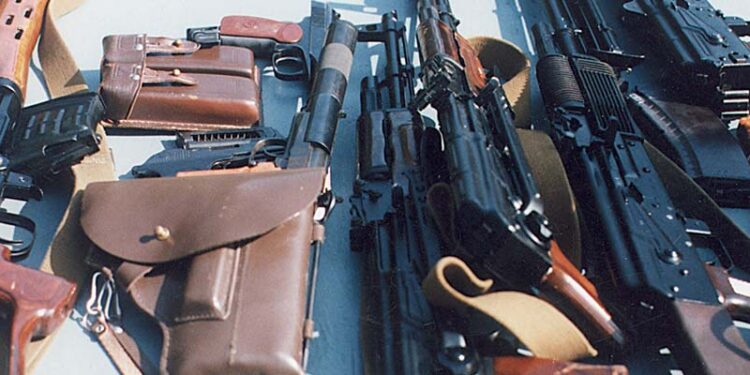By Robb Krott
During my last visit to the small Baltic nation of Latvia I observed a practice session for Latvia’s premier pretteroristi vieniba (counter-terrorist unit) the Drosibas Policijas Pretterorisma Vieniba aka “OMEGA, “formerly known as SIG – Special Intervention Group. It was not my first experience with the Latvian hostage rescue specialists. In 1993 I was a guest of the Latvian Police at an old Soviet army base outside of Riga, now Latvia’s Academy of National Defense and the Valdibas Apsardzes Parvalde (Government Security Service). The VAP was originally the 3rd Company, Internal Forces Unit, of the Interior Ministry’s Special Regiment. The VAP, under the direct control of the Deputy Minister of the Interior, is similar to our Secret Service and consists of the Escort (Bodyguard) Unit. Drivers Section, a Criminal Investigation Section and the counter-terrorist unit. Under the Ministry of the Interior the VAP performs the full Secret Service role as well as duties assigned to our FBI’s HRT and to our Treasury agents. SIG/OMEGA functions as Latvia’s “Delta Force” despite their being three other special tactical teams (spedialo uzdevuma vieniba) prepared to take on domestic and foreign terrorists and deal with hostage situations there is the Latvian military’s Specialo Uzdevuma Vieniba (known as the NBS), the civilian police force’s Mobilais Policijas Pulks, and the Zemessardzes (Home Guard) Specialo Uzdevumu Vieniba. Given the limited size and abilities of Latvia’s fledgling defense forces OMEGA is also prepared to contribute to the nation’s defense in the military special operations role.
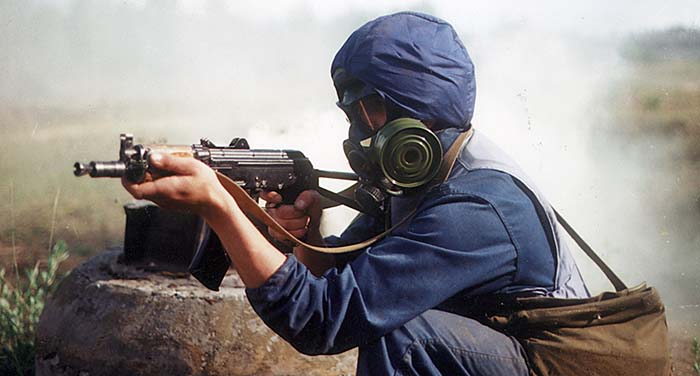
It was during my first visit to Latvia in 1994 that I first met Colonel Aleksis Konosonoks (the major) serving as the Deputy Chief of VAP and as the officer in charge of the presidential and VIP bodyguarding unit. Alex was formerly a Soviet Spetanaz officer. Spetsnaz (spetsalnaya naznacheniya – special purpose forces) is the name given to the special forces of Soviet military intelligence, the GRU Glavnoye Razvedyvatenoye Upravleniye. They were sometimes called reydoviki (raiders) or okhotnik (hunters). Officers, like Alex, were trained in the reconnaissance faculty of the Kiev Higher Combined Arms School and the Special Faculty of the Ryazan Higher Airborne School. Specialists in sabotage, hand to hand combat, and silent killing techniques, their task, in wartime, was to seek out and destroy nuclear facilities, attack command centers, and disrupt power grids. Additionally, each Spetsnaz brigade’s headquarters company was made up of career officers, the elite of the elite, specifically organized as assassins…to hunt down and assassinate enemy political and military leaders. In peacetime, they were hidden in the sports teams of their military district. They were professional athletes in boxing, wrestling, karate, shooting, track and field, skiing, and sport parachuting. Some even made the Olympic teams. Under their guise as athletes they were able to travel abroad into their operational areas. Before the breakup of “the Evil Empire” the Soviet Union maintained the largest body of special forces troops in the world.
Alex was a rising star in Spetsnaz. He became an instructor with the 4th Spetsnaz Brigade and later went on to an MVD police special unit. But that was before Latvia gained independence. Alex is one of the few ethnic Russians awarded a Latvian passport by the government. He was responsible for much of the weapons and demolition training which the Latvian counter-terrorists receive.
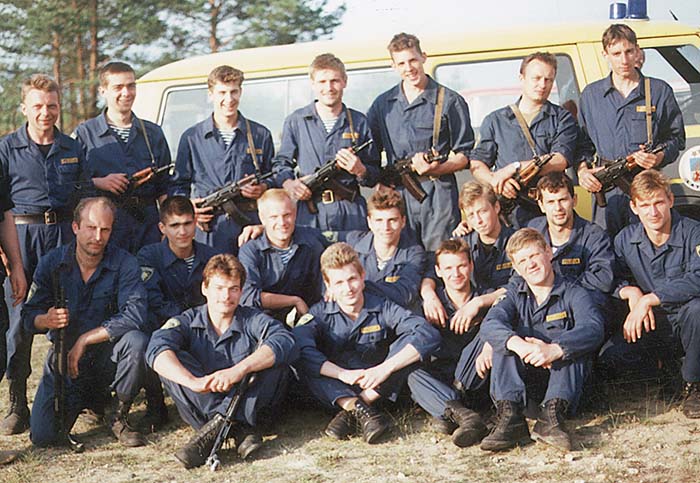
The Russian Mafia
In 1994 (and still today) the Escort Unit and the SIG troopers had to contend with Mafia financed hitmen armed with the latest weaponry. On the second day of my first visit to Latvia a government minister was gunned down in broad daylight on a street corner in Riga. It was a suspected mob hit. The dead minister had refused a protective escort. In Russia, (especially in St. Petersburg renown for the “Leningrad Mafia”) there are many “Afghantsy” (Afghanistan War veterans) who need to eat. They end up working for private armies in some of the breakaway republics or for the mob. Former Soviet Special Forces guys such as Spetsnaz or Paratroopers aka Desantniks hire their trigger fingers out to make ends meet. Most are experienced in mokriye dela – “wet work”…assassinations. If they don’t have ready access to a firearm they employ kholodniye oruzhiye “cold weapons” knives, garrotes, bludgeons. According to a friend of mine with Moscow police contacts, there are an average of 200 plus gun battles in Moscow every month. Those are the shootings they know about. The hitmen of choice are ex Soviet Spetsnaz who usually fly from city to city. They slip in and slip out. When they arrive they’re handed a Tokarev, make the hit, collect their money (enough to eat for a month or so) and fly back out. Then they began flying abroad to do contracts hits, to Scandinavia, Sweden in particular, and according to an acquaintance ( and former KGB officer) in the intelligence business, to “Little Russia” Brighton Beach, New York, as well. The price which has since risen was the same, about twenty bucks US, plus the plane ticket to JFK.
At the old Spetsnaz Polygon (training base) in Adazi near Riga I spent the afternoon watching the counter-terrorist teams execute many of their drills, including a terrorist take down-hostage rescue exercise. The counter-terrorist team was composed of some very professional, athletic, and highly motivated young men. I was impressed with their performance. Some were veterans of KGB, MVD, Spetsnaz, or parachute units. I was very impressed with their entry drills. They quickly and expertly attacked urban facades, entering windows tactically, and effectively deploying the team against their targets. They reacted well to the use of tear-gas and also successfully engaged “terrorists” and rescued the “hostage”.
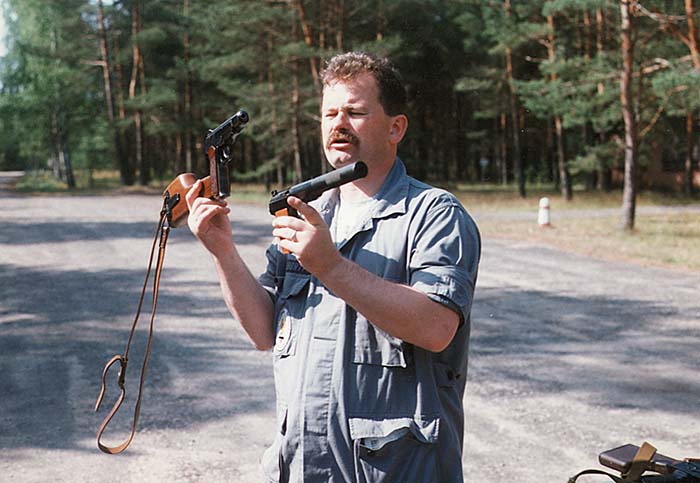
Whereas the personal protection specialists in the Escort Unit carried a variety of pistols the SIG troops then carried a Makarov pistol on a lanyard as personal sidearm and an AKS-U submachine gun. The Makarov is a double action pistol similar to the Walther PPK. It fires the Makarov 9mm ( 9 x 19mm) cartridge. In my opinion the Makarov was a less than ideal sidearm for this type of work, but that’s all they had. The AKS-U is a 5.45mm submachine gun, basically a stubby-nosed AK-74 with a triangular folding stock and the standard 30 round Kalashnikov magazine. Variations of this design are known as the Krinkov and the AKR.
Out to the Range
The following day after PT and a hasty breakfast I went out to VAP’s weapons range located deep in the pine forest of the Adazi Spetsnaz polygon for weapons firing. Orientation and familiarization. I was able to fire all weapons in the SIG inventory save for the RPG-7, and I’d had enough experience with them in the Balkans. Everything in the Soviet inventory has been used by foreign terrorists in the past. Middle East terrorist groups favor the Kalashnikov series of assault rifles and the RPG-7.
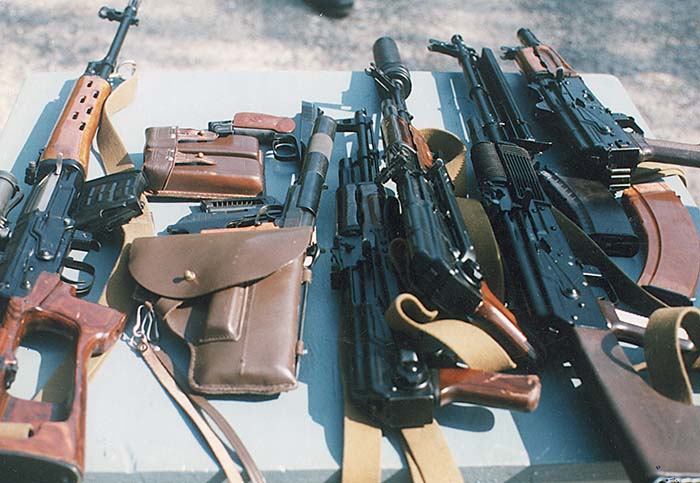
The RPG-7 (rocket propelled grenade) anti-tank rocket launcher is a common terrorist and assassination weapon, especially the RPG-7V which is the two piece paratrooper model and more easily transported and concealed. RPGs are being used more and more frequently by European terrorists. The IRA has used the RPG extensively. Two RPG-7s were used by members of the Red Army Faction in Germany during the assassination attempt on General Frederick Kroesen, commander in chief US Army Europe, September 15, 1981. One rocket passed through the trunk of the General’s limo before exploding, the other flew over its target. General and Mrs. Kroesen escaped with only minor injuries.
At the range the long guns were worked with included the Avtomat Kalashnikova series of weapons: late production RPK-74 (Rushnoi Pulyemet Kalashnikov) squad automatic weapon chambered for 5.45mm, AKS-U 74, AKS-74, AK-74, suppressed AKM with special sub-sonic 7.62x35mm ammo, and the SVD Dragunov sniper rifle. In 1994 Latvian police sniper-counter-snipers were still using the military surplus snaperskaya SVD Dragunov firing the old 7.62mm (7.62 x 54R rimmed cartridge) and an inadequate Model PSO-1 four-power telescopic sight. This is because the SVD was designed as a military tactical sniping rifle with an effective engagement range of no more than 500 meters.
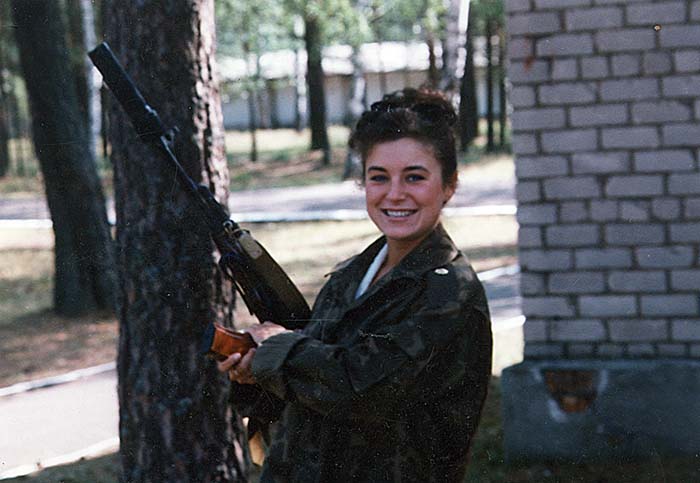
Later I fired the Stechkin machine pistol (APS) in the holster/stock configuration. On full automatic. Very sweet. I fell in love. A true machine-pistol, the Stechkin is a 9mm blowback operated selective fire pistol. It’s equipped with a detachable shoulder stock holster and a twenty-round staggered box magazine. At the time of my visit this weapon was very popular with the bodyguards of Latvia’’ Escort Unit. They carry and use it in much the same manner as our Secret Service carried their Uzi submachine guns during the Reagan Presidency. Unfortunately, the Stechkin is also a favorite of the Russian mob and the fundamentalist Muslim groups in the USSR’s breakaway republics. It’s a very good close-combat weapon, and in the hands of a professional, deadly on full automatic at ranges up to twenty-five meters. With the shoulder stock in place and using aimed shots (on semi-auto) it’s effective out to about 150 meters.
The PB-69 suppressed Makarov is also an excellent weapon given its design parameters and operational requirements. The low light reticle aiming system consisted of two tritium dots that were lined up vertically as opposed to the three dot sighting system seen on most western pistols. When I fired it the integral silencer worked flawlessly. This weapon was originally designed as a KGB assassination pistol. The Latvian use this weapon in scenarios where sentries or guard dogs must be eliminated prior to making a forced entry hostage rescue, or where all terrorists can’t be taken out simultaneously.
While putting several hundred pistol rounds down range I also familiarized myself with the PSM 5.45mm pistol which is very rare anywhere in the west. The PSM (pistolet samozaryadniy malogabaritniy – miniature semi-automatic pistol) was developed by Tikhon Lashnev’s design team at Tula KB in 1969. The PSM’s 7N7 5.45mm cartridge is a necked-down 9x18mm Makarov case. Designed as a small, concealable weapon for high-ranking staff officers, the Russians also concentrated on beefing up the 5.45x18mm cartridge’s effectiveness against body armor or “flak vest”. The PSM round will penetrate up to 45 layers of Kevlar. A civilian version of the PSM, the Baikal 441, was designed for import and sale to the U.S. market. Izmash modified the PSM to meet U.S. import requirements, re-chambering it for 6.35mm Browning / .25 ACP, replacing the flat aluminum grips with wood and equipping the pistol with a loaded chamber indicator and adjustable sights. The 1994 ban on importation prevented any Baikal 441’s from being imported.
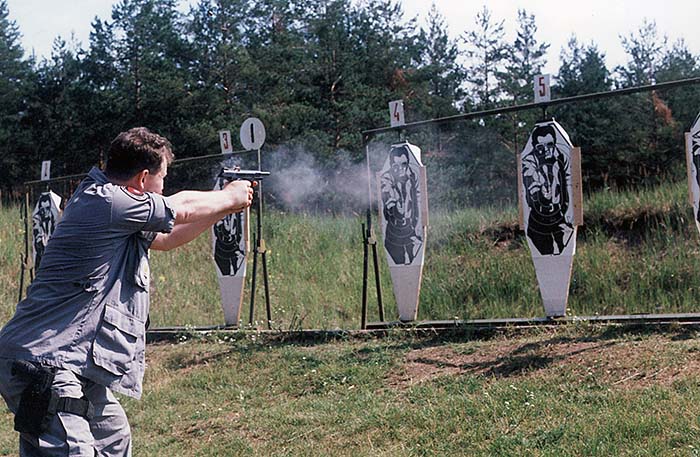
Two very unique weapons which I “got my hands on” were the BG-15 40mm Grenade Launcher (the Soviet GP-25 “Kastyor”) and the KS-23 Russian Law Enforcement Shotgun chambered for 23mm / 6 gauge. This robust shotgun (the largest production pump gun ever made) has a three (plus one) round magazine and fires a unique array of cartridges including CS gas rounds, anti-vehicle, as well as buckshot. The TsNIITochmash KS-23 “tactical shotgun” is designed a “special carbine” by the Russians, but is known as the Drozd (Thrush). Firing this 8.5 pound weapon inappropriately will frequently result in injuries to the operator. The KS-23 is also available in a short barreled, pistol grip version (KS-23M). Cup and spigot type grenade launchers can be attached. The KS-23 is especially useful in blowing door locks, taking out windows, disabling car engine blocks, and destroying car tires.
The GP-25 under barrel grenade launcher was first fielded in Afghanistan in combat against the Mujahideen where it quickly proved its worth as squad level fire support. This double action rifled launcher with 400 meter tangent sight fires the VOG-25 (impact fused) and VOG-25P (bounding) grenade rounds. The grenades are HE (high explosive) with pre-fragmented steel sleeves. The rounds detonate on impact or self-detonate in 14-19 seconds. Made by Tula KBP, the GP-25 is simple to operate, being muzzle loaded.
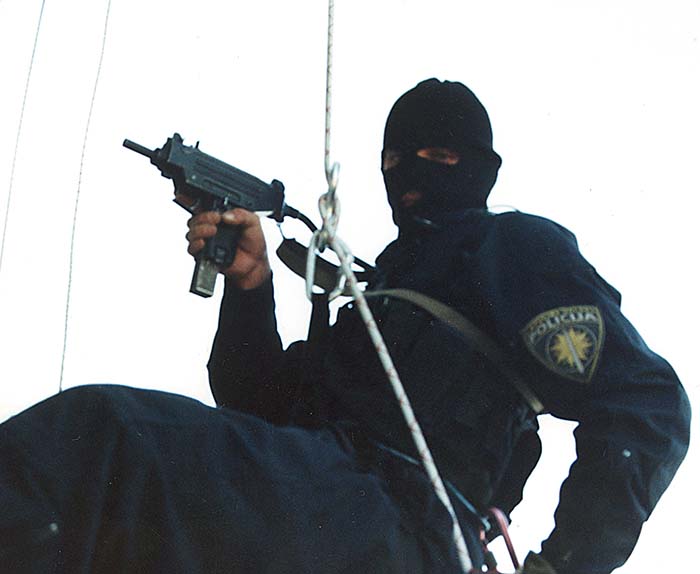
New Name and Weapons
These weapons were still in the inventory in 1996 when I talked to the armorer. I quickly became acquainted with the unit’s new additions, however. After catching up on things with Alex in his office we went down to the shooting range to observe the OMEGA teams. My old friend Sergey Taranov was now commanding the counter-terrorist unit. Targets were head-sized balloons attached to human silhouettes in various configurations. There’d been some recent changes regards equipment. Previously the SIG troops carried a Makarov pistol on a lanyard as a personal sidearm and an AKS-U submachine gun. Now the shooters were armed with “job Lot” Springfield Armory 9mm semi-autos. Better than a 9 x 18mm Makarov but still, in my opinion, not a very good choice for an entry team sidearm. The team had recently gone though a training program headed up by Israelis. The Israeli presence in the Baltics showed in the team’s less than wonderful choice of submachine gun – Mini-Uzi 9mm machine pistols. If Springfield 9mm pistols are a lousy choice for an entry team sidearm then Mini Uzis are an even worse choice for a primary weapon.
The Israelis also sold weapons to Latvia’s northern neighbor, Estonia,. Estonian soldiers are issued folding stock Israeli 5.56mm Galil rifles. The 5.56mm is entirely the wrong cartridge. Why? Well, shortly after I arrived in Estonia in 1996 the government issued its extremely blunt yet official defense policy should the Russians ever invade: “Kill as many Russians as you can and then fade into the woods, become guerrillas, and continue to kill as many Russians as you can”. The problem with this scenario is this: who is going to re-supply Estonia with 5.56mm ammo? The Israelis? I doubt it. The U.S. of A.? I really doubt that as well. The Estonians should have bought Bulgarian Aks in 5.45mm. Then they could just strip dead Russians of their ammo, if not their ammo and the weapon. Admittedly, the choice of a 5.56mm weapon may have something to do with Estonia’s desire to join NATO.
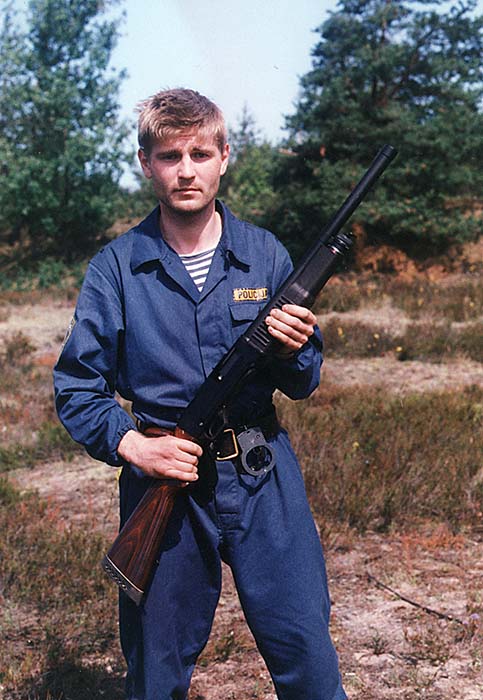
When I first visited the Latvian SIG in 1994 they desperately needed to replace their military surplus hardware. Unfortunately, this was not a high priority for additional funding at a time when Latvia was still struggling with all the problems that accompanied its newly found independence. The SIG had to make do for the time being. At this time they were working on getting some HK MP-5s and some Colt .45s, Glocks, or possibly SIG Sauer 9mm pistols. I’d hoped they would purchase some handguns in the “offensive pistol” configuration, such as the Heckler and Koch OHWS (Offensive Handgun Weapons System) in .45 ACP with sound/flash suppressor and Laser Aiming Module. At the time I suggested they look at the silenced HK-MP5K with laser sighting to replace their AKS-Us and recommended the Macmillan line of precision sniping rifles to replace their clunky intermediate range Dragunovs.
Like anywhere else, these special policemen must make the best use possible of the weapons and a limited budget they have while their procurement officer and commanders fight for better hardware. Regardless, the Latvian VAP’s counter-terrorist unit does a good job with some time proven ordnance.
| This article first appeared in Small Arms Review V2N7 (April 1999) |



